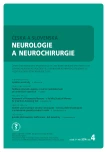Spinal Arteriovenous Malformations – Two Case Reports
Authors:
T. Andrašinová 1; B. Adamová 1,2; A. Krajina 3; T. Andrašina 4
Authors place of work:
Neurologická klinika LF MU a FN Brno
1; CEITEC – Středoevropský technologický institut, MU, Brno
2; Radiologická klinika LFa FN Hradec Králové
3; Radiologická klinika LF MU a FN Brno
4
Published in the journal:
Cesk Slov Neurol N 2014; 77/110(4): 505-509
Category:
Kazuistika
Autoři děkují dr. Georgesu Rodeschovi z Department of Diagnostic and Therapeutic Neuroradiology at Hôpital Foch (Suresnes, Francie) za cenné rady při klasifikaci a léčbě spinálních AV malformací a za pomoc při léčbě pacientky uvedené ve druhé kazuistice.
Summary
Spinal arteriovenous malformations are a group of rare diseases with highly diverse clinical manifestations. The optimal therapeutic practice should always be selected individually and patients should be sent to specialized centres. The objective of this paper is to provide a structured classification of spinal AVMs, their differential diagnosis and therapy, and to present two case reports. The first report is concerned with a case of a 27-year-old man who developed severe pain in the lumbar spine with predominantly meningeal symptomatology. An AVM fed by a hypertrophic radiculopial artery was found on the thoracic spine (Th11/12) MR. A specialized centre performed successful embolization of an arteriovenous shunt. The second report presents a case of a 41-year-old woman, who felt sudden sharp pain in the neck while skiing. Neurologically, she developed an incomplete spinal cord lesion with quadriparesis with left-sided accentuation of severe intensity and sensation threshold at C1. The MR and MRAG of the cervical spinal cord and the following DSA of vertebral artery detected AVM fed by the left posterior spinal artery. Elective endovascular embolization was indicated and the patient was treated at a specialized institute in France.
Key words:
spinal vascular malformation – arteriovenous malformation – spinal subarachnoid hemorrhage
Zdroje
1. Barrow DR, Awad IN. Spinal vascular malformations. 1st ed. New York (NY): Thieme Medical Publisher 1999.
2. Medel R, Crowley RW, Dumont A. Endovascular management of spinal vascular malformations: history and literature review. J Clin Neurosci 2001; 8(4): 299– 304.
3. Kunc Z, Bret J. Diagnosis and treatment of vascular malformations of the spinal cord. J Neurosurg 1969; 30(4): 436– 445.
4. Lasjaunias P. Classification of spinal cord arteriovenous malformations. In: Berenstein A, Lasjaunias P, Brugge KG (eds). Surgical Neuroangiography 2.2. Clinical and Endovascular Treatment Aspects in Adults. 2nd ed. Berlin: Springer 2004: 767– 774.
5. Krajina A, Náhlovský J, Rodesch G. Endovaskulární léčba cévních onemocnění míchy. In: Krajina A, Peregrin JH (eds). Intervenční radiologie, miniinvazivní terapie. 1. vyd. Hradec Králové: Vydavatelství Olga Čermáková 2005: 462– 470.
6. Krings T. Vascular malformations of the spine and spinal cord: anatomy, classification, treatment. Clin Neuroradiol 2010; 20(1): 5– 24.
7. Kim JK, Spetzler RF. Classification and surgical management of spinal arteriovenous lesions – arteriovenous fistulae and arteriovenous malformations. Neurosurgery 2006; 59 (Suppl 5): S195– S201.
8. Torok C, Laufer I, Gailloud P. Spontaneous resolution of a thoracic spinal epidural arteriovenous fistula caused by stabbing injury. Spine 2013; 38(11): E683– E686. doi: 10.1097/ BRS.0b013e31828cf993.
9. Schick U, Hassler WE. Spinal vascular diseases. In: Lumenta Ch, Di Rocco C, Haase J, Mooij J (eds). Neurosurgery. 1st ed. Berlin: Springer 2010: 393– 397.
10. Krings T, Mull M, Gilsbach JM, Thron A. Spinal vascular maformations. Eur Radiol 2004; 15: 267– 278.
11. Krings T, Geibprasert S. Spinal dural arteriovenous fistulas. AJNR Am J Neuroradiol 2009; 30(4): 639– 648. doi: 10.3174/ ajnr.A1485.
12. Smrčka M, Juráň V, Navrátil O, Sedmík J, Šprláková- Puková A. Arteriovenózní malformace conus medullaris – kazuistika. Cesk Slov Neurol N 2013; 76/ 109(4): 508– 511.
13. Veznedaroglu E, Nelson PK, Jabbour PM, Rosenwasser RH. Endovascular treatment of spinal cord arteriovenous malformations. Neurosurgery 2006; 59 (Suppl 5): S202– S209.
14. Chiriac A, Baldof J, Dobrin N, Poeata I. Embolic materials for cerebral endovascular theraphy. Romanian Neurosurgery 2010; 17(2): 171– 181.
15. Sheikh S, Busl K, Ning M. Spinal dural arteriovenous fistula mimicking prostate hyperplasia. J Emerg Med 2011; 41(6): e137– e140. doi: 10.1016/ j.jemermed.2008.05.017.
Štítky
Dětská neurologie Neurochirurgie NeurologieČlánek vyšel v časopise
Česká a slovenská neurologie a neurochirurgie

2014 Číslo 4
- Metamizol jako analgetikum první volby: kdy, pro koho, jak a proč?
- MUDr. Lenka Klimešová: Multioborová vizita může být klíčem k efektivnější perioperační léčbě chronické bolesti
- Nejčastější nežádoucí účinky venlafaxinu během terapie odeznívají
Nejčtenější v tomto čísle
- Vyšetření senzitivity
- Genetická variabilita u poruchy pozornosti s hyperaktivitou (ADHD)
- Spinální arteriovenózní malformace – dvě kazuistiky
- Přínos opakování nepotvrzujícího testu mnohočetné latence usnutí (MSLT) pro stanovení diagnózy narkolepsie
